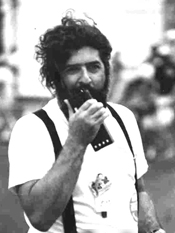 |
→ January 2007 Contents → Column
|
Swimming
January 2007
|
 |
||||||
|
Q "What the hell?"
I am still asleep, dreaming of deep-voiced Sirens moaning from overpowering waters, sound streaming from the murky throat of the Styx.
I am on my way to that other place.
"What?"
No, I am at home, there is a startled cat on my feet, and it is the Mississippi River that runs at the foot of Marigny Street. It is the Mississippi that sounds its low. Sounds it loudly.
Even though the river is three blocks from my home, the slow echoes are strong enough to rattle picture frames and the windows of my bedroom. They sing a long and steady moan, a howl from some primeval soul. Though they are controlled, steady, consistent. I begin to understand.
The orange tabby curls.
I listen. First one, then another.
Now there are many. Five simultaneous singers find a chord and maintain it. It goes on and on. It resonates. A stirring, physically moving harmony carrying irresistible emotion and inscrutable message.
Yet, I am comforted.
The boat horns were loud enough to wake me, and are gentle enough to put me back to sleep.
And so, I sleep again …
The horns have to be blown, and loudly, when the fog comes in like it has the last three days, because just here the river does its tightest turn, at Algiers Point. A restaurant used to stand on the opposite bank, on that tiny peninsula jutting into the river. You could sit with your cocktails and your meal and for hours watch the giant ocean-going vessels make their way around the Point.
It is a masterful dance. The river pilots first power into the turn then suddenly jerk hard to port, the stern sliding all the way around with the bow locked in place mid-river.
Sitting at dinner looking through tall glass French-shuttered windows, the vessels literally pivoted around your table.
It was dizzying. Then, just at a precise moment, the pilot gunned the engines full ahead, to fall instantly again into the deep, straight vessel channel as the river passes the Vieux Carré.
It is a frightening maneuver in the broad daylight. It is a miraculous combination of engineering and intuition in the dark and fog. And they must stay out of each other's way, these huge moving structures, as long, steady lines of ships both come in from, and travel to, the Gulf of Mexico at every hour of the day and night. Through the heart of New Orleans.
Thus this morning's symphonic dirge.
When I finally climb from bed, the slowly evaporating fog has already softened the many ragged post-Katrina edges that remain in the neighborhood all these months later. An orange glow tints the thick wet blanket of moisture as the sun finds its way slowly to mount slate-armored rooftops.
This is a rougher place now. True, it is populated by much the same stubborn, ragtag army of carpenters and sculptors, plumbers and painters as before the hurricane. Hell, I live here. But there are new elements, strangers from all over the country, all over the world, walking our streets, looking to cash in on the gold rush of federal money and cheaply-purchased ruined housing.
New Orleans is a city that lives in metaphor.
I am drawn to the levee mid-morning, a short walk, chicory-bitter creamed coffee in hand. A warehouse and dock sit atop the large earthen mound, the water, mimicking the color of my beverage, lapping at its edges. This is the levee that held, and continues to hold, the Mississippi River within its confines. It has my personal confidence and gratitude. My home took no water in the epic of 2005.
A thick cream off a cappuccino rolls into the streets.
The same water that drowned us, that destroyed our homes, that poisoned our parks and trees, she gives us this beauty today.
I wrote once some years back about the foghorns. I tried to fabricate metered lines, speaking of them like some huge herd of mournful whales, traveling downriver with their echoes, singing to one another as they tried to once again find deep, safe water. I am now glad to have lost that bit of writing.
Poetry has no place in this City, not for the moment. These are more literal times.
And today, I look at the water and am grateful.
There is nothing else to do, is there?
© Jim Gabour
|
|||||||
Back to January 2007 Contents
|
|

